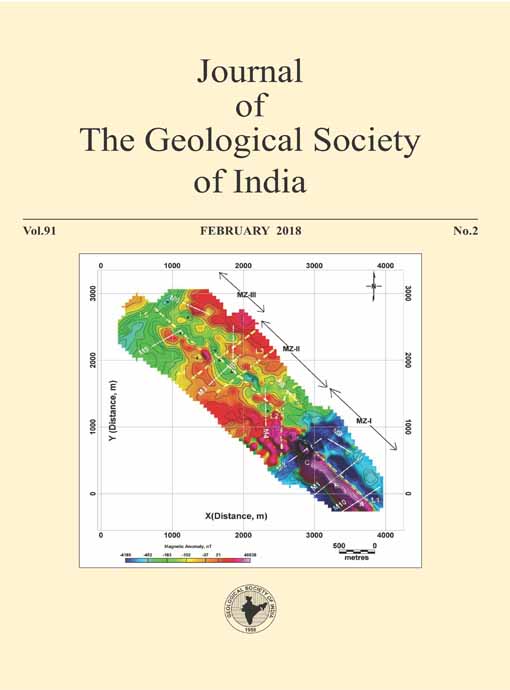A Petrological and Geochemical Account of Subsurface Noritic Intrusion in the Western Part of Bundelkhand Massif, Shivpuri District, M.P.
DOI:
https://doi.org/10.1007/s12594-018-0828-7Abstract
Subsurface exploration for uranium in the northwestern part of Bundelkhand massif, near Khor area, Shivpuri dist., M.P., resulted in intercepting a substantial thickness of mafic rock within Bundelkhand granitoid. Intercepts of this mafic rock at various levels in the boreholes, indicate that the rock mainly occurs as dykelike intrusion and fracture-fills within Bundelkhand granite. It is essentially composed of hypersthene and plagioclase, with or without olivine, leading to the characterisation as hypersthene microdolerite, noritic dolerite and norite (±olivine), depending on the grainsize and variation from intergranular to ophitic texture. Chemically, the rock is characterised by av. 49.09% SiO2, 2.46%TiO2, 2.33 Fe2O3, 9.45% FeO, 5.75% MgO, 8.37% CaO and 0.96% K2O. The normative composition ranges from 3.53% quartz, 46.86% plagioclase, 12.58% diopside, 19.24% hypersthene. The olivine normative samples show av. 5.65% olivine. Geochemical plots indicate an intra-plate affinity along with oceanic signature, while presence of mineralogical and normative olivine, together with the REE pattern, point towards a lower crustal or mantle source. The mineralogical and normative presence of either quartz or olivine in these mafic rocks implies that it has an intermediate character between the tholeiitic dolerite dykes and the komatiite-type ultramafics reported from Bundelkhand craton. The complex geochemical signature of the rocks also reveals that both intra-continental as well as a mixture of oceanicto upper mantle signatures are evident. The present study is a first time report of the occurrence of this hitherto unknown noritic body at depth within the Bundelkhand granite, which has no visible surface expression. The findings may strengthen the existing concept of a continuum between Rajasthan craton in the west and Bundelkhand craton in the east, as a single protocontinent.Downloads
Metrics
Issue
Section
Downloads
Published
How to Cite
References
Bowen, N.L. (1928) Evolution of the igneous rocks, Princeton University Press, Princeton, 334p.
Burke, K. and Dewey, J. F. (1973) Plume generated triple junctions: key indicators in applying plate tectonics to old rocks: Jour. Geol., v.81, pp.406–433.
Cabanis, B., and Lecolle, M. (1989) Le diagramme La/10-Y/15-Nb/8: un outil pour la discrimination des series volcaniques et la mise en evidence des processus de melange et/ou de contamination crustale, C. R. Acad. Sci. Ser. 2, v.309, pp.2023-2029.
Dilek, Y., Furnes, H. and Shallo, M. (2007) Suprasubduction zone ophiolite formation along the periphery of Mesozoic Gondwana, Gondwana Res., v.11, pp.453–475.
Felsche, J., and Hermann, A.G. (1978) Yttrium and lanthanides, chapter 39, In: Wedepohl, K.H. (Ed.), Handbook of Geochemistry: Verlin, SpringerVerlag, v.2(5), pp.57-71.
Floyd, P.A. and Winchester, J.A. (1975) Magma type and tectonic setting discrimination using immobile elements, Earth Planet. Sci. Lett., v.27, pp.211-218.
Fugro Airborne Surveys Pty Ltd, Australia (2008) Geophysical Interpretation report of Mohar area, Shivpuri dist., M.P, Unpublished.
Haldar, D. and Ghosh, R.N. (2000) Eruption of Bijawar lava: An example of Precambrian volcanicity under stable cratonic condition, Proceedings volume. Int. Sem. Precambrian crust in Eastern and Central India, IGCP368, Bhubaneshwar, India, pp.151-170.
Hall, R.P. and Hughes, D.J. (1990a) Noritic magmatism. In: R.P. Hall and D.J. Hughes (Eds.), Early Precambrian Basic Magmatism. Blackie, Glasgow, pp.83-110
Irvine, T.N. and Baragar, W.R.A. (1971) A guide to the chemical classification of the common volcanic rocks. Canadian Jour. Earth Sci., v.8, pp.523548.
Kale, V. (1991) Constraints on the evolution of the Purana basins of peninsular India. Jour. Geol. Soc. India, v.38, pp.231-252.
Kuno, H. (1959) Origin of Cenozoic petrographic provinces of Japan and surrounding areas, Bull. Volcanol., v.20, pp.37-76.
Larsen, E.S. (1938) Some new variation diagrams for groups of igneous rocks. Jour. Geol., v.46, pp.505-520.
LeBas, M.J., LeMaitre, R.W., Streckeisen, A. and Zanettin, B. (1986) A chemical classification of volcanic rocks based on the total alkali-silica diagram. Jour. Petrol., v.27, pp.745-750.
Meert, J.G., Pandit, M.K., Pradhan, V.R., Banks, J.,Sirianni, R., Stroud, M., Newstead, B. and Gifford, J. (2010) Precambrian crustal evolution of Peninsular India: A 3 billion year odyssey Jour. Asian Earth Sci., v.39, pp.483-515.
Mondal, M.E. A. and Ahmad, T. (2001) Bundelkhand mafic dykes, central Indian shield: implications for the role of sediments subduction in Proterozoic crustal evolution. Island Arc, v.10, pp.51-67.
Mullen, E.D. (1983) MnO/TiO2/P2O5: a minor element discriminant for basaltic rocks of oceanic environments and its implications for petrogenesis. Earth Planet. Sci. Lett., v.62, pp.53-62.
Park, R.G. (1988) Geological structures and moving plates, Glassgow, Blackie, 337p.
Pearce, J.A. and Canne, J.B. (1973) Tectonic setting of basic volcanic rocks determined using trace element analyses. Earth Planet. Sci. Lett., v.19, pp.290-300.
Pearce, J.A. and Norry, M.J. (1979) Petrogenetic implications of Ti, Zr, Y and Nb variations in volcanic rocks. Contrib. Mineral. Petrol., v.69, pp.3347.
Rao, Mallikarjun, J., Pooranchandra Rao, G.V.S., Widdowson, M. and Kelley, S.P. (2005) Evolution of Proterozoic mafic dyke swarms of the Bundelkhand granite massif, central India. Curr. Sci., v.88(3), pp.502-506.
Rogers, J.J.W. (1996) A history of continents in the past three billion years. Jour. Geol., v.104, pp.91-107
Rogers, J.J.W. and Santosh, M. (2002) Configuration of Columbia, A Mesoproterozoic supercontinent. Gondwana Res., v.5(1), pp.5-22.
Rogers, J.J.W. and Santosh, M. (2003) Supercontinents in earth's history, Gondwana Res., v.6(3), pp.357-368.
Sharma, R.S., Sills, J.D. and Joshi, M. (1987) Mineralogy and metamorphic history of norite dykes within granulite facies gneisses from Sand Mata, Rajasthan, NW India. Mineral. Magz., v.51, pp.207-215.
Sharma, R.S. (2009)Cratons and fold belts of India. Springer, 304p.
Shervais, J.W. (1982) Ti-V plots and the petrogenesis of modern and ophiolitic lavas. Earth Planet. Sci. Lett., v.59(1), pp.101-118.
Srivastava, R.K. and Gautam, Gulab, C. (2012) Early Precambrian mafic dyke swarms from the Central Archaean Bastar Craton, India: geochemistry, petrogenesis and tectonic implications. Geol. Jour., v.47, pp.144-160.
Sun, S.-s. and McDonough, W.F. (1989) Chemical and isotopic systematics of oceanic basalts: implications for mantle composition and processes. Geol. Soc. London Spec. Publ., v.42, pp.313-345.
Wager, L.R and Deer, W.A. (1939) Geological investigations in East Greenland, Part 3. The petrology of the Shaergaard intrusion, Kangerdludssuaq, East Greenland, Medd. Gronl., v.105(4), pp.1-352.

 Madhuparna Roy
Madhuparna Roy






